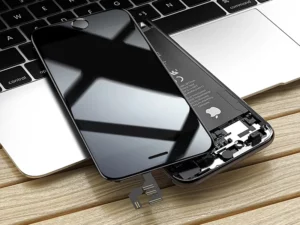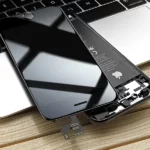Have you ever wondered what magic happens when you tap your smartphone screen? How does it become a brilliant color and image display at your fingertips? Let’s explore mobile phone LCDs, where technology meets imagination.
Before smartphones, we used clunky phones with monochromatic screens. Remember pixelated Nokia phones? We’ve progressed since then!
Mobile Phone Screen Evolution
We started small. Cathode Ray Tube (CRT) displays were like little boxy TVs. However, carrying a CRT in your pocket wasn’t ideal. We needed better. LCD followed.
Mobile screens got bigger, lighter, and brighter. LCD panels become mobile device standard. Why? Compact, energy-efficient, and superb image quality. Why not?
The narrative continues. OLED screens have pushed our limits in recent years. That’s another story.
Dear reader, buckle up as we explore phone LCDs and the engineering that brings your phone to life!
1. Understanding LCD Technology: What is an LCD in a Phone

Why is an LCD so important to your smartphone? Good inquiry and fascinating answer. LCD, which stands for Liquid Crystal Display, is genuine and affects how you’re reading this line.
The Basics of Liquid Crystal Display (LCD)
Let’s simplify. LCD’s “Liquid Crystal” is interesting. Imagine small, disorganized soldiers who need an electric current (their commander) to line up. They influence light transmission and what you see on your phone screen when they align.
In phones, LEDs illuminate these crystals. Electric current affects liquid crystal orientation, which blocks or lets light through. With millions of these happening at once, your phone gets a gorgeous, high-resolution display!
However, LCDs vary. They’ve evolved into many varieties with distinct traits. Let’s examine smartphones’ most common ones: TFT/IPS LCD.
Different Types of LCD Screens in Phones
Thin Film Transistor LCD (TFT) Liquid Crystal Display revolutionized LCD technology. How? TFT screens have transistors for each pixel, improving response speed and image quality. Nice, right? TFT panels are power-hungry and have limited viewing angles.
LCDs advanced too. In-Plane Switching Liquid Crystal Display. TFT’s limited viewing angle? IPS fixed it with true colors from wider viewing angles. The colors stay accurate whether you’re gazing at your phone head-on or sideways. IPS panels are more power-efficient than TFTs.
Smartphones go beyond TFT and IPS. The Apple-branded Retina Display is a high-definition IPS screen. HTC’s Super LCD (SLCD) offers better viewing angles and lower power consumption than regular LCDs.
LCD technology may seem complicated, but if you grasp it, it’s fascinating. Since its beginnings, additional varieties have improved displays, power efficiency, and user experience. So the next time you’re dazzled by your phone’s vibrant colors, you’ll know there’s an army of liquid crystals and LEDs behind it!
2. LCD vs. Other Phone Screen Technologies
Let’s investigate several additional smartphone screen tourists as we continue our journey. LCD screens haven’t changed anything. OLED and AMOLED are strong competitors. How does LCD compare? Jump in.
LCD vs. OLED: Key Differences and Advantages

LCD and OLED fight like superheroes. Each has unique powers, so choosing depends on what you value most. Let’s compare significant benefits.
As we learned, LCD backlights illuminate liquid crystals. This offers bright colors and greater resolutions. LCDs are cheaper to make, making devices cheaper.
LCDs’ ‘blacks’ aren’t really black. Since the lighting is always on, they appear dark grey.
OLEDs, however, work differently. OLED uses organic compounds that emit light when electric current is supplied instead of a backlight. Pixels are light sources. OLED screens display true black, which increases contrast and color vibrancy. OLED screens are thinner, lighter, and refresh faster than LCDs.
OLEDs have downsides. They cost more to make, which raises device prices. Burn-in, where static pictures are permanently ‘burned’ onto the screen, can also occur.
Choosing Between LCD and OLED for Your Phone
LCD or OLED? Technology often depends.
OLED may be right for you if you value true blacks, rich colors, and spending more. OLEDs’ greater refresh rates can improve gaming and HD phone viewing.
However, an LCD screen may be better for a low-cost, high-resolution display. LCDs are also resistant to screen burn-in, making them an ideal choice.
Thus, what matters most in a phone screen is your preference. Understanding LCD and OLED pros and cons can help you choose. It shows how far screen technology has come when we can choose our display!
3. Impact of LCD Technology on Phone Usage
After exploring LCD and OLED screens’ superhero powers, let’s analyze how LCDs affect our daily phone usage. Screens affect battery life, visibility, resolution, and user experience.
LCD Brightness/Visibility
First, brightness and visibility. Ever struggled to read your phone in the hot sun? Because screen brightness and technology affect bright light visibility.
LCD screens have continual backlights, making them viewable in strong light. Due to its constant backlight, it may not be as visible as OLED screens, which may adjust pixel brightness.
There’s hope. IPS LCDs have wide viewing angles. Even at angles, the screen retains color accuracy and contrast. Whether you’re looking at your phone straight on or sideways, it’s the same viewing experience.
LCD and Phone Battery Life
Next, battery life. Screen technology affects how often you charge your phone.
LCD panels’ continual lighting consumes electricity regardless of what’s displayed. The power draw is similar whether your screen displays a bright, vivid image or a dark scenario.
OLED screens, where each pixel is lighted, modify the tale. OLED screens save power by turning off pixels while displaying dark scenes or black colors. LCDs can’t switch off parts of their backlight to save power.
It’s not simple. Screen resolution, refresh rate, and phone software optimizations might affect battery life. However, understanding LCD power usage can help you understand your phone’s battery life.
LCD or OLED panel technology extends beyond bright colors and precise visuals. From viewing pleasure to charging frequency, everything affects your daily phone experience. It’s fascinating to observe how smartphone screens will change as technology advances. So watch the screen! The future is bright and efficient.
4. The Future of LCD Technology in Phones
We’ve seen how LCD technology has transformed smartphone interaction. LCDs’ future? Will newer, flashier technologies replace them? Let’s imagine phone LCD technology’s future.
Current Trends in LCD Phone Screens
LCDs still dominate smartphones. However, fascinating trends are pushing this technology’s limitations.
Refresh rates are rising. For better graphics and ultra-responsive touch input, LCDs are now available with 120Hz or even 240Hz refresh rates. Like a flipbook animation and a high-definition movie.
Power efficiency is emphasized. LCD manufacturers are experimenting with dynamic backlights, variable refresh rates, and software optimizations to save power and battery life.
Predicting Phone Screen Technology
We can make some reasonable estimates about the future, even in an area as fast changing as smartphone electronics.
OLED technology is growing. OLED screens’ higher contrast ratio, genuine blacks, and power-saving possibilities while displaying darker content are attracting high-end smartphones. LCDs have advantages in screen burn-in and manufacture cost.
MicroLED technology is coming. MicroLEDs, the next big thing, combine LCD and OLED features including high brightness, contrast, and energy economy without burn-in. They’re difficult and expensive to make, especially for cellphones’ small screens.
But LCDs won’t die off. Quantum dot LCDs (QLEDs) are an example of manufacturers improving LCD technology. They offer OLED-like performance at reduced costs, potentially changing smartphone screens.
LCDs are essential to smartphones, even if the leading technology changes. Phone screens will be brighter, clearer, and more immersive. As we travel, it’s exciting to imagine what these technologies will bring. We’ll watch!
5. Conclusion
As we conclude our examination of LCD technology in phones, it’s apparent that this intriguing innovation has changed how we use and experience smartphones.
LCDs have proven their worth from humble beginnings to the front of some of the world’s most popular phones. They’re a digital standard due to its brightness, color accuracy, and affordability.
Time changes all technology. OLED and MicroLED are heating up rivalry. As seen, LCDs change. LCDs are adapting to produce high-quality, cheap smartphone displays with greater refresh rates and quantum dot technologies.
Whether you like LCDs, OLEDs, or MicroLEDs, these technologies have a huge impact on our lives. As they improve, our digital portals promise a brighter, clearer, and more immersive future. Here’s to watching the screen and awaiting the wonders!




